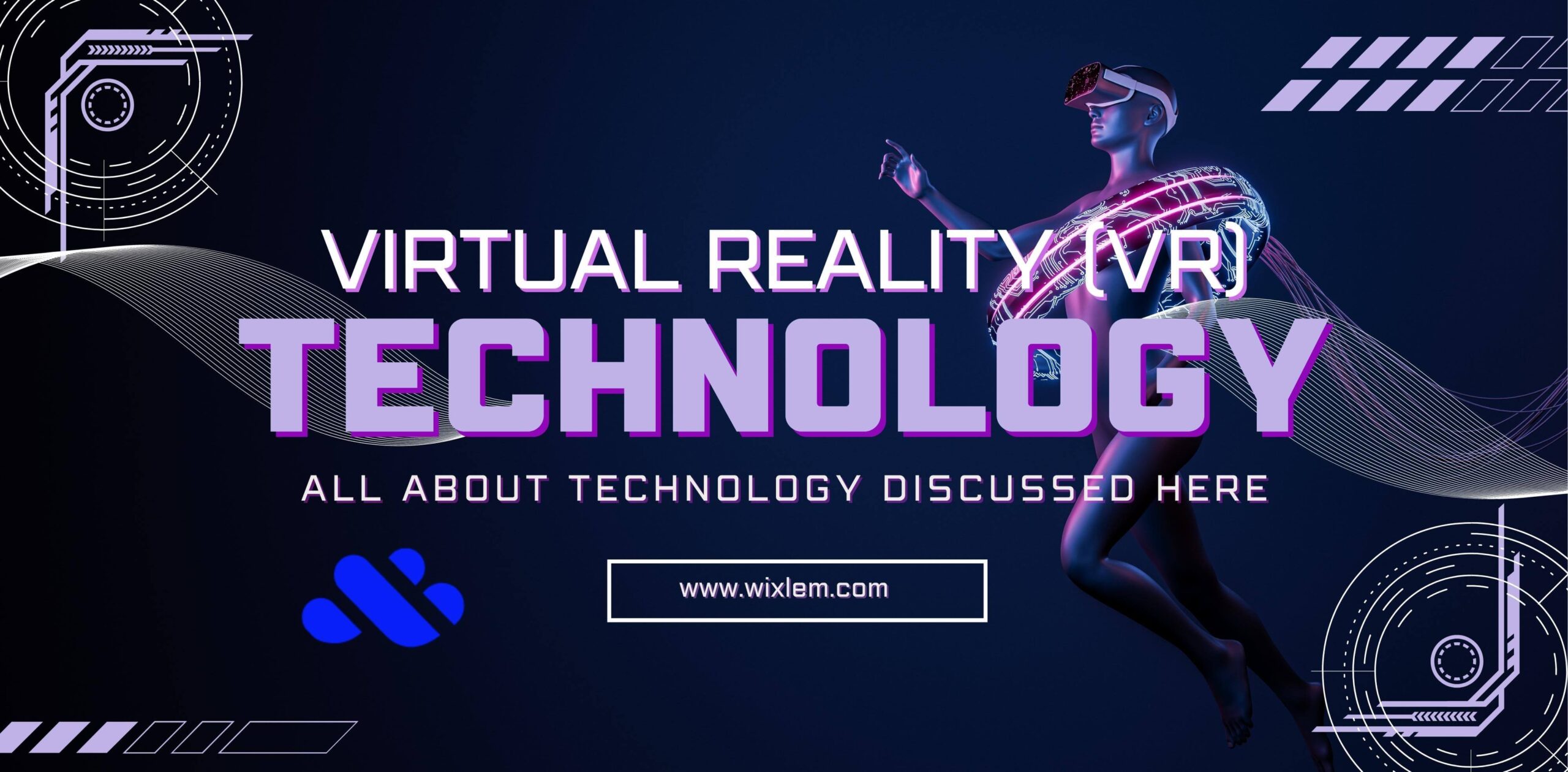Power of Virtual Reality Virtual reality (VR) technology may be a rapidly developing industry that changes the way we interact with the world. From gaming to education, healthcare to marketing, VR technology transforms how we experience and engage with different sectors. VR technology is discussed in this article, including its history, advantages, challenges, and applications. I will also discuss how Virtual Reality (VR) Technology works and its different types and provide examples of its use in various industries.
Understanding Virtual Reality (VR) Technology
Utilizing cutting-edge visuals, sound, and other sensory input, Virtual Reality (VR) Technology gives clients an immersive experience. It has many uses, including entertainment, healing, and education. VR experiences require powerful computers, VR headsets, and other input devices like gloves or controllers. Power of Virtual Reality is also necessary to use special software.
Computer graphics, processing power, and display technology developments have fueled VR technology growth. VR applications will be more prevalent across various industries as technologies advance and develop. Yet, issues must still be resolved, such as expensive equipment prices and scant content availability.
The History of Virtual Reality Technology
The first head-mounted display (HMD) was created by Ivan Sutherland in the 1960s. VR innovation became more accessible in the 1990s. In the early 2000s, Virtual Reality (VR) Technology experienced a decline due to expensive equipment and limited applications. With the development of smartphones and affordable VR headsets, the industry experienced a resurgence.
Advantages of Virtual Reality Technology
-
Virtual Reality (VR) Technology can offer immersive instruction and training experiences that are more interesting and efficient than conventional approaches.
-
Increased safety is possible thanks to Virtual Reality (VR) Technology, which may be used to imitate hazardous circumstances, creating a secure setting for training and preparedness.
-
Virtual Reality (VR) Technology makes it possible to collaborate remotely and hold virtual meetings while saving money on trip expenses.
-
Virtual Reality (VR) Technology can offer distinctive, immersive entertainment experiences that are beyond conventional media formats.
Challenges of Virtual Reality Technology
High equipment costs: Specialized hardware, such as VR headsets and fast computers, is needed for VR technology, which can be pricey.
Content accessibility: VR material is not as widely available as traditional media forms.
Possible health risks: VR technology, mainly used for prolonged periods, can lead to motion sickness and eye strain.
User adoption: Consumers’ willingness to adopt upcoming technologies and user adoption rates are critical factors in VR technology success.
How Virtual Reality Technology Works
Creating computer-generated settings that simulate either the real world or an imagined one is how Virtual Reality (VR) Technology functions. Users put on headgear that tracks their motions and modifies the environment to match.
The headset’s display provides an immersive experience, offering a 360-degree perspective of the virtual environment. Power of Virtual Reality Devices for user interaction: Allowing users to engage with the virtual environment, such as gloves or controllers, makes the experience more enjoyable.
Applications of Virtual Reality Technology
Gaming: Virtual reality technology has several uses in the gaming sector, delivering immersive gaming experiences beyond conventional media forms.
Real estate: Potential buyers can inspect properties remotely using virtual reality (VR) technology to create virtual property tours.
Healthcare: Virtual reality (VR) technology can train medical workers, alleviate phobias and anxiety, and provide patients with distraction during treatment or procedures.
Education: By using VR technology to create immersive learning environments, teachers may help students engage more deeply with scientific theories or historical events.
Tourism: Virtual tours of popular tourist spots can be made using VR technology, giving potential visitors an immersive experience.
Marketing: Marketing campaigns could use VR technology for immersive experiences and innovative product showcasing.
Types of Virtual Reality Technology
Tethered VR headsets provide the most immersive VR experience. Mobile VR headsets are more portable and inexpensive than tethered ones since they use smartphones as displays. Power of Virtual Reality Customers prefer self-contained VR headsets without a computer or smartphone.
Gaming Industry
VR technology makes gaming more immersive and gives players more fun ways to engage with the game world. Various gameplay dynamics are now possible thanks to VR technology, which is not achievable with conventional gaming.
VR technology has made the game business more competitive by creating new market opportunities for independent developers and small companies.
Popular virtual reality games: VR titles include Beat Saber, Half-Life: Alyx, Job Simulator, and Superhot VR.
Real Estate Industry
The real estate industry and virtual reality technology have changed how homes are bought, rented, and sold. Power of Virtual Reality Prospective buyers can see the property firsthand with VR technology without leaving their homes. Also, building firms and real estate developers can employ VR technology to present their work and represent home upgrades.
Healthcare Industry
VR technology is causing a stir in the healthcare industry by enhancing patient outcomes and educating healthcare personnel. Patients can get therapy in virtual reality, and medical procedures can be practice safely and controlled. VR technology can also help healthcare personnel become more skilled and knowledgeable about medical procedures.
Education and Industry
Virtual reality technology alters education by offering immersive and interactive learning opportunities. Power of Virtual Reality Students can participate in instructional simulations, virtual field trips, and online classroom experiences. Moreover, training for specific fields like engineering, architecture, and medicine can be provided via VR technology.
Tourism Industry
Virtual travel experiences are growing in popularity thanks to VR technology applications in the tourism sector. Travelers can take an online tour of their location, taste the local sights and customs, and even partake in simulated sports like skydiving and scuba diving. By enabling individuals to travel the world from their homes, virtual reality technology has created new opportunities for the tourist sector.
Marketing
To give customers fully immersive brand experiences, VR technology is also used in marketing. Businesses may develop VR marketing efforts that immerse clients in a distinct setting and provide them with a novel method to interact with the brand. Several companies are using VR technology to remain ahead of the competition since it is an effective tool for boosting brand recognition and engagement.
Examples of Virtual Reality Technology in Different Industries
VR technology examples in different industries include:
-
Gaming: Beat Saber, Half-Life: Alyx, Job Simulator
-
Real estate: Matterport, Virtual Experience
-
Healthcare: Medical Realities, Applied VR
-
Education: Google Expeditions, Alchemy VR
-
Tourism: Visit, Escape
-
Marketing: The North Face, Jaguar
How to Create Virtual Reality Content
Choose your VR content creation tool: Solidarity, Unbelievable Motor, and Blender are some VR content creation devices. Select the gadget that perfectly fits your needs and skills.
Create 3D models or import existing ones: You can make 3D models or leverage existing ones to create your VR environment. Once you’ve chosen your VR substance creation tool.
It can be more engaging and immersive to create an immersive VR environment if you add interactivity. Consider adding features such as teleportation, object manipulation, and user interface elements.
Test and refine: Before releasing your VR content, test it thoroughly and refine any issues. Make sure your content runs smoothly and provides an optimal user experience.
The Future of Virtual Reality (VR) Technology
Increased adoption in different industries: Games, education, and healthcare already use Virtual Reality (VR). Architecture and engineering will adopt the technology as it becomes more affordable and accessible.
Advancements in hardware: VR will perform better with higher-resolution displays and tracking technology.
Improved accessibility: VR technology can be expensive and requires a powerful computer. More individuals will be able to do it as innovation becomes more reasonable and available.
Integration with augmented reality (AR): AR technology is expected to complement VR technology, enhancing the user experience further. Combining the two technologies can create even more immersive and interactive environments.
Conclusion
Virtual Reality (VR) Technology is a rapidly growing industry transforming how we experience and engage with different sectors. From gaming to healthcare and marketing education, VR technology provides immersive and interactive experiences that were once impossible. While the technology faces several challenges, its advantages and potential applications make it an exciting area to watch in the coming years.
The following post you will like:
Unlocking Virtual Reality’s Power: Tips for Successful Meetings and Events
Seizing the Potential of Internet of Things Devices in 2023
Accelerate Business: Digital Transformation Strategies in 2023
FAQs
What are the advantages of virtual reality technology?
Virtual reality technology offers several advantages, including creating immersive experiences, improving training and education, and enhancing entertainment experiences. Virtual reality technology can also reduce travel costs and provide remote collaboration opportunities.
What are the challenges of virtual reality technology?
Despite its advantages, virtual reality technology faces challenges, including high equipment costs, limited content availability, and potential health risks such as motion sickness and eye strain. Additionally, the technology’s success depends on user adoption and technological advancements.
How can virtual reality technology be used in marketing?
Virtual reality technology can create immersive brand experiences in marketing and advertising. Virtual reality marketing campaigns can give customers an immersive and engaging experience that increases brand awareness and engagement.
What tools are necessary for creating virtual reality content?
Virtual reality content requires specialized software and hardware. Some popular VR content creation tools include Unity, Unreal Engine, and Blender. 360-degree cameras and VR headsets are also necessary to capture and view VR content.
What is the future of Virtual Reality (VR) Technology?
The future of virtual reality technology looks promising, with technological advancements and increased adoption rates. Various industries will benefit from virtual reality technology development as it becomes more affordable and accessible. In addition to virtual reality (VR), augmented reality (AR) enhances VR even further.



